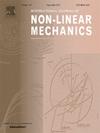Numerical analysis of two-dimensional elastoplastic problems based on zonal free element method
IF 2.8
3区 工程技术
Q2 MECHANICS
International Journal of Non-Linear Mechanics
Pub Date : 2025-04-01
DOI:10.1016/j.ijnonlinmec.2025.105102
引用次数: 0
Abstract
In this paper, a weak-form numerical method, the zonal free element method (ZFrEM) is introduced to solve two-dimensional elastoplastic problems. In ZFrEM, the whole domain is divided into several sub-domains, and then a series of points are used to discretize each sub-domain. The Lagrange isoparametric element concept in the finite element method (FEM) is employed to form the collocation element for each collocation node with the neighboring points, and the system equations are generated with the point-by-point. The continuous model separates strain into elastic and plastic components, ensuring that stress variation is solely dependent on the elastic component of the strain, which is consistent with classical elasticity theory, and assuming that plastic strain is independent of stress increments, which results in a nonlinear system of equations with the coefficient matrix dependent on the current incremental stress state. For the nodes in the plastic state, a stress regression technique aligns stresses with defined yield surfaces. Three numerical examples are given to verify the accuracy and convergence of the present method for solving the elastoplastic problems.
基于区域自由元法的二维弹塑性问题数值分析
本文引入一种弱形式的数值方法——带状自由单元法(ZFrEM)来求解二维弹塑性问题。在ZFrEM中,将整个域划分为几个子域,然后用一系列的点对每个子域进行离散。采用有限元法中的拉格朗日等参单元概念,对每个配置节点与相邻点形成配置单元,逐点生成系统方程。连续模型将应变分为弹性和塑性两部分,保证应力变化完全依赖于应变的弹性分量,这与经典弹性理论相一致,并假设塑性应变与应力增量无关,从而得到一个非线性方程组,其系数矩阵依赖于当前的增量应力状态。对于处于塑性状态的节点,应力回归技术将应力与定义的屈服面对齐。给出了三个数值算例,验证了该方法求解弹塑性问题的准确性和收敛性。
本文章由计算机程序翻译,如有差异,请以英文原文为准。
求助全文
约1分钟内获得全文
求助全文
来源期刊
CiteScore
5.50
自引率
9.40%
发文量
192
审稿时长
67 days
期刊介绍:
The International Journal of Non-Linear Mechanics provides a specific medium for dissemination of high-quality research results in the various areas of theoretical, applied, and experimental mechanics of solids, fluids, structures, and systems where the phenomena are inherently non-linear.
The journal brings together original results in non-linear problems in elasticity, plasticity, dynamics, vibrations, wave-propagation, rheology, fluid-structure interaction systems, stability, biomechanics, micro- and nano-structures, materials, metamaterials, and in other diverse areas.
Papers may be analytical, computational or experimental in nature. Treatments of non-linear differential equations wherein solutions and properties of solutions are emphasized but physical aspects are not adequately relevant, will not be considered for possible publication. Both deterministic and stochastic approaches are fostered. Contributions pertaining to both established and emerging fields are encouraged.

 求助内容:
求助内容: 应助结果提醒方式:
应助结果提醒方式:


